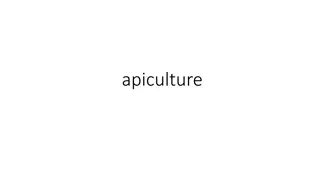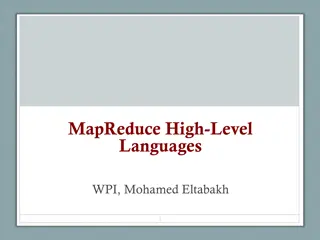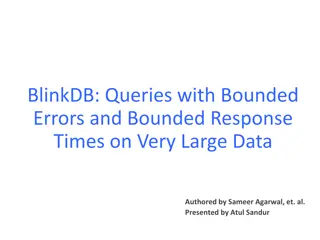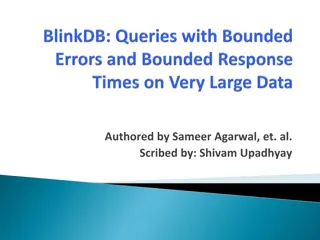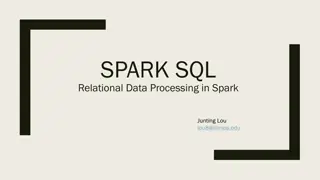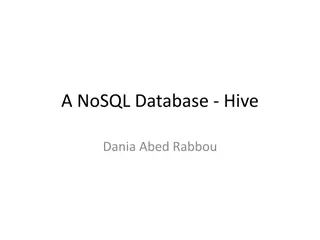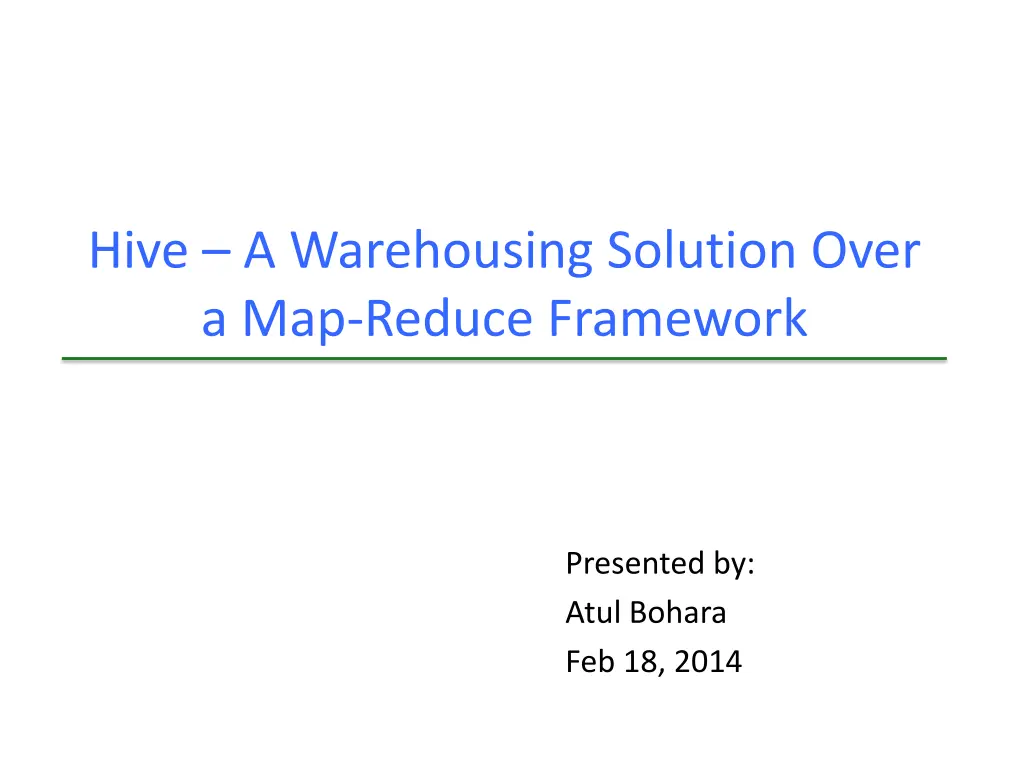
Understanding Hive: A Comprehensive Guide to Data Warehousing Solutions
Explore Hive, an open-source data warehousing solution built on top of Hadoop, offering a high-level SQL-like interface for querying and analyzing large datasets. Learn about its architecture, query language, and conceptual data flow, enabling efficient data processing over a Map-Reduce framework. Discover how Hive addresses the limitations of traditional warehousing solutions, making it an essential tool for big data processing in cloud environments.
Download Presentation

Please find below an Image/Link to download the presentation.
The content on the website is provided AS IS for your information and personal use only. It may not be sold, licensed, or shared on other websites without obtaining consent from the author. If you encounter any issues during the download, it is possible that the publisher has removed the file from their server.
You are allowed to download the files provided on this website for personal or commercial use, subject to the condition that they are used lawfully. All files are the property of their respective owners.
The content on the website is provided AS IS for your information and personal use only. It may not be sold, licensed, or shared on other websites without obtaining consent from the author.
E N D
Presentation Transcript
Hive A Warehousing Solution Over a Map-Reduce Framework Presented by: Atul Bohara Feb 18, 2014
Outline Cloud Programming Background and Motivation Hive Introduction Database Design Hive Query Language Architecture Analysis Conclusion and Discussion
Cloud Programming Applications built for cloud computing - Handle large data sets - Distributed and parallel processing Hadoop, Hive, Pig, HBase, Cassandra, Storm, Spark are some of the most popular systems
Background and Motivation Data, data and more data - FB warehouse grows half PB per day* Traditional warehousing solutions Insufficient and Expensive Hadoop (map-reduce and HDFS) - Scale out, available, fault-tolerant Problem: map-reduce programming model is low level - Hard to maintain and reuse - Limited expressiveness, no schema Solution: Hive *source: http://en.wikipedia.org/wiki/HDFS#Hadoop_distributed_file_system
What is Hive? Open-source data warehousing solution built on top of Hadoop.
Conceptual Data Flow Frequency of status updates based on gender Frequency of status updates based on school Top 10 most popular status memes per school Users Web servers Hive Data Engineer/ Analyst RDBMS or File System Hadoop
Example: StatusMeme Creating Table CREATE TABLE status_updates (userid int, status string, ds string) PARTITIONED BY (ds string) CLUSTERED BY (userid) SORTED BY (ds) INTO 32 BUCKETS STORED AS SEQUENCEFILE profiles(userid int, school string, gender int)
Hive Data Model ds= 2009-03-20 Part-00000 status_ updates ds= 2009-03-21 ds= 2009-03-22 Part-00001 Files Sub-directories HDFS Directory
StatusMeme (contd.) Loading Data LOAD DATA LOCAL INPAT /logs/status_updates INTO TABLE status_updates PARTITION (ds= 2009-03-20 )
StatusMeme (contd.) Frequency of status updates based on gender? Frequency of status updates based on school? Multi-table Insert and Join FROM (SELECT a.status, b.school, b.gender FROM status_updates a JOIN profiles b ON (a.userid = b.userid and a.ds= 2009-03-20 ) ) subq1 INSERT OVERWRITE TABLE gender_summary PARTITION(ds= 2009-03-20 ) SELECT subq1.gender, COUNT(1) GROUP BY subq1.gender INSERT OVERWRITE TABLE school_summary PARTITION (ds= 2009-03-20 ) SELECT subq1.school, COUNT(1) GROUP BY subq1.school
StatusMeme (contd.) Top 10 most popular status memes per school? HiveQL Map-Reduce Constructs REDUCE subq2.school, subq2.meme, subq2.cnt USING top10.py AS (school, meme, cnt) FROM (SELECT subq1.school, subq1.meme, COUNT(1) AS cnt FROM (MAP b.school, a.status USING meme_extractor.py AS (school, meme) FROM status_updates a JOIN profiles b ON (a.userid = b.userid) ) subq1 GROUP BY subq1.school, subq1.meme <(school, meme), cnt> DISTRIBUTE BY school, meme ) subq2; SORY BY school, meme, cnt desc
Hive Query Language SQL-like query language called HiveQL - DDL: Create, Drop, Alter (tables/partitions/columns) - DML: Load and insert Data, select, project, join, aggregate, union all - Primitive and complex data types - Operators and functions - Support for variety of file formats
Hive Architecture External Interfaces - User interfaces like CLI, web UI - APIs like JDBC and ODBC - Other interfaces like Microsoft HDInsight
Hive Architecture Thrift Server - Exposes a simple client API to execute HiveQL statements - Thrift is a framework for cross-language services - Delegates client requests for metadata to metastore or hadoop file system
Hive Architecture Metastore - Stores metadata and statistics for databases, tables, partitions - A relational database or file system optimized for random accesses and updates - Consistency between metadata and data should be maintained explicitly
Hive Architecture Driver - Manages life cycle of HiveQL statement: compilation, optimization and execution Uses a session handle to keep track of a statement -
Hive Architecture Compiler - Translate query statements into a Plan Metadata operations (DDL statements) HDFS operations (LOAD statement) DAG of map-reduce jobs (insert/query)
Hive Architecture Optimizer - Combines multiple joins - Adds repartition operator (ReduceSinkOperator) - Minimize data transfers and pruning - User hinted optimizations
Hive Architecture Execution Engine - Runs DAG of map-reduce jobs on Hadoop in proper dependency order
Query Plan generated by the compiler for StatusMeme Example
Analysis Hive performance benchmark Experiment - To compare performance of Hadoop, Hive and Pig - Executed 4 queries (2 select, 1 aggregation and 1 join query) - Data set: - Grep table, 2 columns, 50 GB data - Rankings table, 3 columns, 3.3 GB data - Uservisits table, 9 columns, 60 GB data Source: Hive performance benchmark: https://issues.apache.org/jira/browse/HIVE-396
Analysis Hive performance benchmark results Source: Hive performance benchmark: https://issues.apache.org/jira/browse/HIVE-396
Conclusion Data warehousing solution on top of Hadoop - Usability (HiveQL, intuitive and precise code) - Extensibility (custom map-reduce scripts, User defined data types and functions) - Interoperability (support for variety of file and data formats) - Performance (optimizations in data scan, data pruning) Hive use cases - Reporting (summarization, ad hoc queries) - Data mining and machine learning - Business intelligence Hive Adopters - Facebook, Netflix, Yahoo, Taobao, cnet, hi5 and many more
Discussion Hive is not suitable for OLTP - No real time queries and row level updates - Latency of minutes for small queries Map-reduce vs Hive (Pig) Map-reduce - complex and sophisticated data processing - Full control to minimize map-reduce jobs - Better in performance than Hive most of the times - Writing Java code for map-reduce is difficult and time consuming Hive - More suited for ad-hoc queries - Intuitive and easy to write SQL like queries
Discussion Hive vs Pig - Hive is more natural to database developers and Pig is convenient for script/perl developers - Hive gives better performance than Pig - Pig is more suited for ETL and data movement, while Hive is better for ad hoc queries
Discussion Hive is evolving as a parallel SQL DBMS which happens to use Hadoop as its storage and execution architecture Increasing HiveQL Capabilities - Insert, update and delete with full ACID support - REGEX support in selecting files for External Table - Support for dual table, information_schema - Improving Explain Optimization Techniques - Cost-based optimization Performance Improvements - Adoption of RCFile for data placement, and most recently the ORC Integration with other Frameworks - Support with HBase, Cassandra
References [1] Hive paper http://www.vldb.org/pvldb/2/vldb09-938.pdf [2] Hive wiki https://cwiki.apache.org/confluence/display/Hive/Home [3] Hive performance benchmarks https://issues.apache.org/jira/browse/HIVE-396 [4] Hive Facebook presentation http://www.sfbayacm.org/wp/wp-content/uploads/2010/01/ sig_2010_v21.pdf [5] Hive vs Pig: Yahoo developers http://developer.yahoo.com/blogs/hadoop/pig-hive-yahoo-464.html [6] Hive Apache JIRA page https://issues.apache.org/jira/browse/HIVE
Backup Slides Extra Material
HiveQL Capabilities Simple and partition based queries Joins Aggregations Multi-table or File inserts Dynamic-partition inserts Local file insert Sampling Union all Array operations Custom map-reduce scripts
Hive Data Model External Tables - Point to existing data directories in HDFS, NFS or local directories - Used for data filtering Serialization/De-serialization (SerDe) - Tables are serialized before storing into directories - Built-in formats using compression and lazy de- serialization - User defined (de)serialize methods are supported, called SerDe s
Compilation Process Parser - Semantic Analyzer - Converts parse tree to block-based internal query representation - Verification, expansion of select * and type checking Logical Plan Generator - Converts internal query to logical plan Optimizer - Combines multiple joins - Adds repartition operator (ReducedSinkOperator) - Minimize data transfers and pruning - User hinted optimizations Physical Plan Generator - Converts logical plan into physical plan (DAG of map-reduce jobs) Converts query string to parse tree





